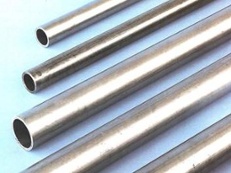At first glance, buying pipe may appear to be confusing, but once you understand the basics, it becomes much easier. Determining the grade of steel is the first step in the process. This provides a basis for additional questions to narrow down the best possible product.

Many first time buyers also struggle when figuring out the size of pipe they need. Here at Continental Steel & Tube we have developed a pipe size chart that can be your go to resource for pipe sizes, and can be downloaded below.
It’s important to note that although the words pipe and tube are occasionally used interchangeably, they are not at all the same thing and have different applications, shapes, and measurement techniques. In general pipe is used to move gas, air, or water while tube is generally for structural use. Pipe is round, but tube can be round, square, or rectangular.
Tube measurement will be covered in a different blog article, but pipe is measured by the length, nominal inner diameter (ID) and pipe “schedule” (wall thickness). It’s important to note that pipe sizes follow an industry standard, so the sizing is the same regardless of grade.
For example, a 1 inch pipe would be as follows:
1″ SCH 40 x 20′
Therefore, the measured size of this pipe is 1.315″OD x .133″WT x 20′
This is where the nominal inner diameter (ID) comes in. In this case the ID 1.049″ will be the inner diameter measurement. The OD size is different for each Size ID; For example 3-1/2″ Pipe will have a 4″ Diameter. This is another aspect of pipe buying that most novices find confusing.
Some other important things to note about sizes: Once the pipe size is higher than 14,” the size called out is actually the outer diameter (OD), instead of the inner diameter, as described above. This remains the OD size from then on, even to the largest-offered pipes.
However, there are still a couple of other exceptions to this rule. For the wall thickness, Sch 40 and Sch STD (Standard) is the same up until the 12″ Pipe. For pipes larger than that, the schedule switches to Sch 40S (STD) or what is referred to as “True Sch 40.”
For example in the case of 12″ Pipe sizes would be as follows:
STD or Sch 40s
12″ SCH 40s = 12.750″OD x .375″WT
or
Sch 40 (True Schedule 40)
12″ SCH 40 = 12.750″OD x .405″WT
This also applies to Sch 80 and Sch 80S.
Please access our chart library below and view our pipe chart for specific details.
Next on the list is to determine whether seamless or welded tubing is required. Grades will commonly be available for both types, so it depends on the specific job. NOTE: you must know what grade you need before they send us an inquiry. We do not determine that.
Furthermore, the pipe end itself can be customized. Options such as having a pipe with beveled ends (BE) or threaded ends can influence your request with us. We need this additional information so that we can properly quote for specific kinds of pipe ends.
Lastly, we always need to know total quantity (footage) of pipe that you require. Please make sure to include this as part of your quote.
To review this information, here’s a quick checklist of what we will need to correctly quote the best pipe for your specific project.
1. Grade of Steel
2. Size of Pipe
3. Seamless or Welded
4. Any special pipe end requirements?
5. Quantity
Should you need a pipe that does not fall on the industry standard pipe list. We can have custom sizes fabricated. If this is something you are interested in, please ask.

